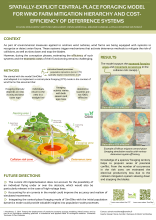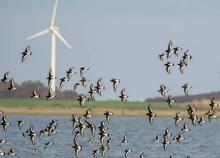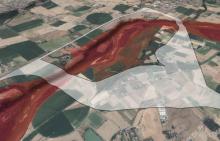This week, we are attending the 8th Conference on Wind energy and Wildlife impacts - CWW2025, the leading international event on wind energy and its interaction with biodiversity, which is being held in Montpellier (France) until Friday.
As part of the poster sessions, we are presenting a special feature of our ecological simulation software SimOïko, specifically designed to analyze the risk of collision between flying species and wind turbines.
It's back to school time, and we're heading back to scientific symposiums and conferences!
In two weeks, we will be attending the Conference on Wind Energy & Wildlife Impacts (CWW), the leading international event on wind energy and its interaction with biodiversity.
Now in its eighth year, the conference will be held in Montpellier, France, from September 8 to 12, and is co-organized by France Renouvelables and our colleagues at Biotope.
We will be presenting a special feature of our ecological simulation software SimOïko, specifically designed to analyze the risk of collision between flying species and wind turbines.
What will transport infrastructures need to look like in 2050 to be biodiversity-friendly?
This was the topic addressed today by our CEO Sylvain Moulherat at the FIRM25 event organized by FEHRL, the international association dedicated to road equipment research.
This presentation enabled him to go back over the Bison project, to which TerrOïko made a major contribution, and whose aim was to build a European roadmap for transport infrastructures that fully integrate ecological issues.
How can we help reduce the risk of collision between trains and wildlife?
Last week, our CEO Sylvain Moulherat was invited to present our work on the subject at the Via Fauna technical seminar.
Via Fauna is a project launched in 2017 by the Fédération Régionale des Chasseurs d'Occitanie (Regional Federation of Hunters), which has led to the development of tools and methods for better integrating ecological connectivity into land-use planning projects and urban planning documents.
PEP-BIOccIA: AI and the future of public service
Since a year ago, the Senate's Foresight Delegation has been focusing on AI and the future of public services. Their work has resulted in the publication of several reports, including one dedicated to environmental issues (*), which was released a few days ago.
The good news is that among the projects and tools cited as examples is the PEP-BIOccIA research project, led by the Occitanie / Pyrénées-Méditerranée Region, in collaboration with OPenIG, CNRS, and our team.
Design and Management of Transport Infrastructure: Methods to Better Protect BiodiversityInfrastructure and Biodiversity Map
Are you interested in the connection between biodiversity protection and transport infrastructure management? Then be sure to check out the latest issue of RGRA, which focuses on these topics.
You will discover an article presenting a study commissioned by Toulouse Métropole. To ensure "no net loss" of biodiversity in its territory despite significant development needs, the community has chosen to integrate the Avoid-Reduce-Compensate (ERC) sequence from the planning and design phase of its projects.





